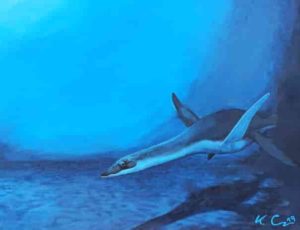
In the Mesozoic era, about 250 to 65 million years ago a large number of reptiles populated the oceans. The most successful were the plesiosaurs, which existed for about the same time as the dinosaurs. Enlarged red blood cells ensured their survival. This was discovered by paleontologists at Bonn University and zoologist Kai R. Caspar from Duisburg-Essen University (UDE). The results can be read in the international bioscientific online journal PeerJ.
Why did the size of the red blood cells increase? The scientists explain this with the environment of the marine animals. “Obviously, the plesiosaur firstly developed in the open sea after their ancestors had migrated from the shallow coastal waters to the high seas. The processes in their bodies adapted accordingly,” says Kai Caspar. The enlarged red blood cells were advantageous for their longer, repeated dives in the open sea. “The larger they are, the more oxygen can be bound per cell,” says the biologist.
For their investigation, the scientists created microscopically thin sections of fossil bones of the plesiosaurs, large (ancient) marine reptiles, and compared them with those of coastal ancestors. “The pattern found is unequivocal: By moving to the high seas, the blood cell size of these marine animals increased rapidly,” summarises the UDE-scientist.
From an evolutionary perspective, this change is obviously still useful. Today`s whales, seals and penguins also have unusually large red blood cells, but their close relatives on land and in freshwater do not. “This supports our assumption that this is a significant adaption of warm-blooded marine life,” says Kai Caspar.
Reference:
Corinna V. Fleischle et al. Hematological convergence between Mesozoic marine reptiles (Sauropterygia) and extant aquatic amniotes elucidates diving adaptations in plesiosaurs, PeerJ (2019). DOI: 10.7717/peerj.8022
Note: The above post is reprinted from materials provided by Universität Duisburg-Essen.










